 By a series of link-hops that began with archaic Greece and what I hope will soon be a post of its own (it all depends on whether I can get my grubby mits on good pictures), today I wound up in Pompeii. With a prosciutto. A prosciutto-shaped sundial, to be exact. It was portable, as far as we know the earliest portable sundial surviving, which is even more notable a title when you consider that it’s made out of bonze and managed to make it through the eruption of Vesuvius in 79 A.D. intact.
By a series of link-hops that began with archaic Greece and what I hope will soon be a post of its own (it all depends on whether I can get my grubby mits on good pictures), today I wound up in Pompeii. With a prosciutto. A prosciutto-shaped sundial, to be exact. It was portable, as far as we know the earliest portable sundial surviving, which is even more notable a title when you consider that it’s made out of bonze and managed to make it through the eruption of Vesuvius in 79 A.D. intact.
It dates the 1st century A.D. and was first unearthed on June 11th, 1755, in the early Bourbon-era excavations of the site of Herculaneum. The sundial was found in the House of the Papyri, a handsome private villa where a library of charred scrolls were discovered. The scrolls got the lion’s share of the attention, but the silver-gilt bronze portable sundial so recognizably shaped like a prosciutto hanging from the bone while it cures did get some love from the Encyclopédie ou Dictionnaire raisonné des sciences, des arts et des métiers, the ambitious knowledge compendium edited by Denis Diderot and Jean le Rond D’Alembert.
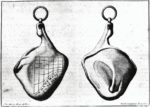 The only problem is the description was not particularly accurate. (Many of the entries in the Encyclopédie left something to be desired in that arena.) The sundial was “in the form of a sleeve,” according to them. In 1762, the first scholarly work to recognize the prosciutto clock for its awesomeness was published. It was the third volume of a much less general encyclopedia — Antiqities of Herculaneum — and the authors corrected the factual errors, barely disguising their contempt that the French encyclopedists couldn’t even recognize a prosciutto when they saw one. Horologists have been discussing the ham with undiminished fervor ever since.
The only problem is the description was not particularly accurate. (Many of the entries in the Encyclopédie left something to be desired in that arena.) The sundial was “in the form of a sleeve,” according to them. In 1762, the first scholarly work to recognize the prosciutto clock for its awesomeness was published. It was the third volume of a much less general encyclopedia — Antiqities of Herculaneum — and the authors corrected the factual errors, barely disguising their contempt that the French encyclopedists couldn’t even recognize a prosciutto when they saw one. Horologists have been discussing the ham with undiminished fervor ever since.
The sundial is now part of the permanent collection of the Museo Archeologico Nazionale di Napoli. It was briefly in New York City this spring as part of the Time and Cosmos exhibition at New York University’s Institute for the Study of the Ancient World. That’s where it found a new fan who introduced new technology to the investigation of the sundial.
Now the “pork clock” ticks once more. Recently re-created through 3-D printing, a high-fidelity model of the sundial is helping researchers address questions about how it was used and the information it conveyed.
The model confirms, for instance, that using the whimsical timepiece required a certain amount of finesse, says Wesleyan University’s Christopher Parslow, a professor of classical studies and Roman archaeology who made the 3-D reconstruction. All the same, “it does represent a knowledge of how the sun works, and it can be used to tell time.” […]
After Parslow was asked about the pork clock, he was inspired to build a 3-D model. He took dozens of photos of the timepiece at its home institution, Italy’s National Archaeological Museum of Naples. A 3-D printer at his university churned out the model—in plastic rather than the original silver-coated bronze—in a matter of hours.
Like the original, Parslow’s model bears a dial, in the form of a slightly distorted grid, on one side. The vertical lines are marked for the months of the year. The horizontal lines indicate the number of hours past sunrise or before sunset.
The original clock is missing its gnomon, the part of a sundial that casts a shadow, but an 18th-century museum curator described it having one in the shape of a pig’s tail, so Parslow re-created that, too.
Parslow then experimented with the sundial outdoors. The clock is hung from a string so that the sun falls on its left side, allowing the attached pig’s tail to cast a shadow across the grid.
The user aligns the clock so that the tip of the tail’s shadow falls on the vertical line for the current month. Finally, the user counts the number of horizontal lines from the top horizontal line to the horizontal line closest to the tip of the shadow. That indicates the number of hours after sunrise or before sunset.
It’s conceivable that he might even be able to tell time to the half-hour, but without the original gnomon he’s having to tinker with curly tail to get the most detailed readings, and it’s not at all clear that the device was meant to be all that precise. A portable sundial was a prestige item more than a practical one and nobody was counting billable hours in 15 minute increments.
The Prosciutto Clock led me to another extraordinary image, this one tweeted by the Pompeii Sites account. This is the collection of pigment cups left behind by painters fleeing the eruption of Vesuvius in 79 A.D., most of them with the pigments or raw materials thereof still in brilliant color.
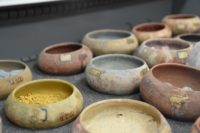
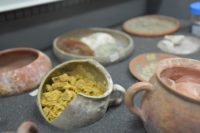
Following the trail of Internet breadcrumbs, I found Dr. Sophie Hay’s reply to the Pompeii Sites’ tweet of the rainbow of pigment jars. She was on the team that excavated those pots, which is insanely cool. The containers and their dazzling contents came from a painter’s workshop near the House of the Chaste Lovers where an unfinished fresco, a red frame around a white square, was found. On the same insula — a large multi-use block of more than 1500 square meters with homes, retail like a bakery and wine shop, and artisan workshops — a room was found in classic Pompeiian “frozen in time” mode. Apparently before the eruption a crew was working on the hydraulic network while painters had started redecorating the frescoes in the main hall. They had just finished the preparatory drawings when something suddenly came up, almost certainly Vesuvius’ roasting hot insides. The artists must have been in a rush because they left all of the pigments, which were certainly expensive not to mention necessary to their livelihood, behind. This great find gave the structure its modern name: the House of the Painters at Work.
The House of the Chaste Lovers, named after a completed fresco depicting a modest kiss at a dinner, belonged to wealthy baker (the bakery storefront next door was apparently his) and is an exceptional survival in a lot of ways. It’s one of very few two-story buildings in Pompeii with the second story still attached to it. The bakery’s oven and millstones are intact, as are two of its stables, complete with skeletal remains of seven animals. It has been excavated off and on since 1982, and the public have only been allowed in on very rare occasions. The week of Valentine’s Day this year was one those occasions, a tribute to the famous fresco with its sweet kiss on the reclining couch.
The pigment bowls were no longer in situ by then. In 2014, Professor Massimo Osanna, Director General of the Pompeii archaeological site, deposited the entire collection of pigments cups in the Laboratory of Applied Research which specializes in the study and conservation of Pompeii’s unique combination of archaeological materials, including organic, mineral and lithic remains. It has a state-of-the-art climate control system to keep the most delicate remains from degrading, and is therefore best equipped to preserve the vivid color of the ancient pigments.
Graphic artist Gareth Blayney made a series of drawings of how the shopfronts might have looked before the Vesuvian apocalypse for Dr. Hay and they are all beautiful, but the one of the paint shop truly does the riot of pigment jars justice.
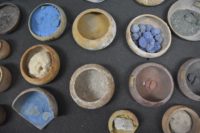
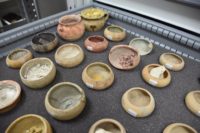

“In Polybius’s time [the Greek historian, c. 200 – c. 118 BC], the Gauls [sic!] exported salt pork each year to Rome in large quantities, where it was sold in different cuts: rear cuts, middle cuts, hams, and sausages. This meat, after having been salted with the greatest care, was sometime smoked.”
———-
That is to say, back then, wine(!) was exported into what is now France, and traded in against ‘prosciutto’ from abroad ‘in large quantities’.
Caesar himself, for example, knew exactly what he was up to, before he went for his ‘shopping’ tour. The Celtic ‘Hallstatt’ period has even its name from ‘Hallstatt’ in what is now Austria (‘Hal’- or ἅλας = ‘Salt’) in a region that is still referred to as Salzkammergut. That salt and the meat, by the way, is still used for exactly that purpose :boogie:
———-
Thus, a successful ‘prosciutto-dealer’ from Pompeii might have used this -extraordinary cool and rather posh- portable sundial as some form of ‘status symbol’ – Who knows ?
The month names reflect the changes to Quintilus and Sextilis but not the changes made by Caligula, Claudius and Nero. I am assuming the 18th century illustration is correct and not a restoration for expelling the sundial use.
Scott, its a sundial, and those are ‘hours’, not months: Quintilis and sextilis are ‘the 5th’ and the ‘6th’, i.e. as always, ‘ante meridiem’ (AM) and ‘post meridiem’ (PM) – You could possibly blame Caligula for quite a lot, but here he is totally innocent 😉
At least in his Histories(Bk II), Polybios referred to ‘Gallia Cisalpina’ (‘before the Alps’), i.e. in what today is northern Italy and southern France, with Marseilles and the river Rhone as gateway into ‘Transalpine Gaul’ (i.e. ‘behind the Alps’).
Rome was looted and burned down in 390BC and the Capitoline Hill laid under siege for several months, until later the Italian part of ‘Gallia Cisalpina’ was made Roman.
:hattip:
blame ME … I messed up the formatting :confused:
You are right. I had a brain fart.
I was thinking about the analema on some sundials. Still I was way off base.
The Wikipedia article “Roman Timekeeping”A diagram illustrating variable lengths of the segments called hora and vigilia.[7] Forum Romanum AD 8.
Note that if the chart is folded horizontally on the noon line (6th hour) and vertically on the solstice line you have the “slightly distorted grid” marking on the “ham clock” and the month markings in the order listed.
I am not an expert on sundials. A horizontal dial contains a analemma that shows the months and zodiac . I am not sure how a vertical dial like the “ham clock” would show the same information. Interesting though.
Maybe there is more knowledge than first appears in the distorted grid.
Can any horologists help here?
I thought the months listed dated the sundial between 41 and 79 AD.
I really do not see numerals on the dial just month abbreviations split and paired on the solstices.
Sundials can provide much more information than just the daylight hours.
Very good point, Scott. Myself, I did not even have a look at it, nor am I an expert.
Seemingly, sundials were used for all kinds of purposes, almost similar to some form of ‘swiss army knife’. Take installations like ‘Stonehenge’ for instance: There was definitely more to it than just to tell the hour of the day. Devices like the ‘Antikythera’ machine are -so to speak- only ‘in parts‘ understood.
Coming back to sundials, and depending on something that is referred to as ‘projection’, some do claim that (e.g.) the sun declination is indeed a means to tell a particular date.
Polybios had put it like this:
———————
“Its fertility is not easy to describe. It produces such an abundance of grain, that often in my time the price of wheat was four obols per Sicilian medimnus and that of barley two obols, a metretes of wine costing the same as the medimnus of barley. Panic[um] and millet [presumably, Proso millet, a.k.a panicum miliaceum] are produced in enormous quantities, while the amount of acorns grown in the woods dispersed over the plain can be estimated from the fact that, while the number of swine slaughtered in Italy for private consumption as well as to feed the army is very large, almost the whole of them are supplied by this plain. The cheapness and abundance of all articles of food will be most clearly understood from the following fact. Travellers in this country who put up in inns, do not bargain for each separate article they require, but ask what is the charge per diem for one person. The innkeepers, as a rule, agree to receive guests, providing them with enough of all they require for half an as per diem, i.e. the fourth part of an obol, the charge being very seldom higher. As for the numbers of the inhabitants, their stature and beauty and their courage in war, the facts of their history will speak. […]
… Their possessions consisted of cattle and gold, because these were the only things they could carry about with them everywhere according to circumstances and shift where they chose. They treated comradeship as of the greatest importance, those among them being the most feared and most powerful who were thought to have the largest number of attendants and associates. On their first invasion they not only conquered this country but reduced to subjection many of the neighbouring peoples, striking terror into them by their audacity. Not long afterwards they defeated the Romans and their allies in a pitched battle, and pursuing the fugitives, occupied, three days after the battle, the whole of Rome with the exception of the Capitol, but being diverted by an invasion of their own country by the Veneti, they made on this occasion a treaty with the Romans, and evacuating the city, returned home. After this they were occupied by domestic wars, and certain of the neighbouring Alpine tribes, witnessing to what prosperity they had attained in comparison with themselves, frequently gathered to attack them. … ”
:hattip:
Mmm…lard!